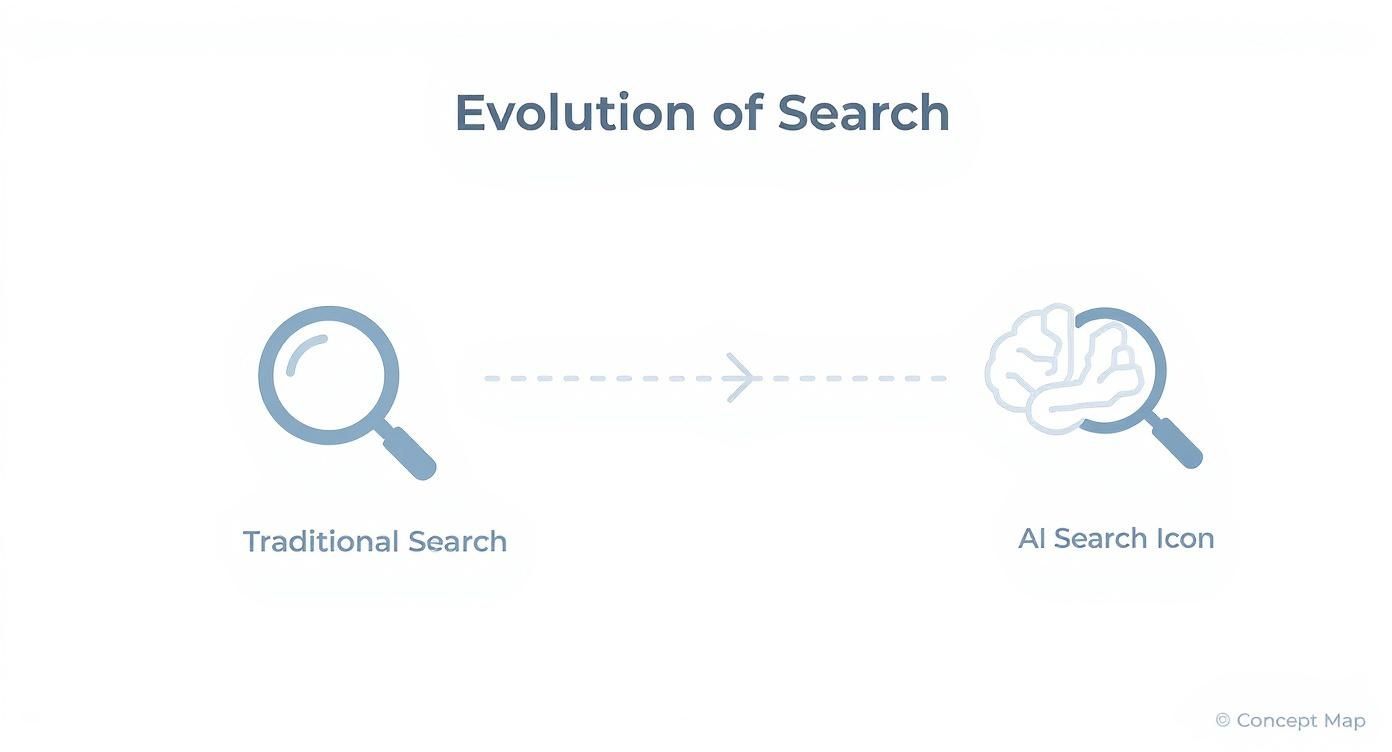Optimizing for generative AI search isn't about chasing the #1 spot anymore. It’s about creating content so clear, authoritative, and well-structured that an AI model trusts it enough to use it as a primary source for its answers.
The goal has shifted from ranking to becoming the answer.
How Generative AI Is Reshaping Search
Let's use an analogy. For decades, traditional search has been like a library's card catalog. You ask a question, and it gives you a list of shelves (links) where you might find your answer. It works, but you still have to pull each book off the shelf, open it, and find the information yourself.
Generative AI search completely changes that.
Think of it as having a personal research librarian. You ask your question, and they go read all the relevant books for you, then come back with a concise, synthesized summary. This leap from a list of links to a direct, conversational answer is the new reality we're all navigating.
Understanding the New Search Landscape
You can see this change in action with features like Google's Search Generative Experience (SGE), which serves up "AI snapshots"—detailed, generated answers right at the top of the results. Instead of just getting a list of blue links, users get an immediate, comprehensive response.
The concept map below shows this powerful evolution from a simple list of resources to a direct answer engine.

This visual makes it clear: search is moving from a navigational tool to an answer engine. This puts a huge premium on content that is factual, well-organized, and easy for an algorithm to digest. The game is no longer just about being on the list; it’s about becoming the source material for the AI's summary.
This shift means your content has to be more than just relevant; it must be a definitive source that an AI can confidently cite. Your website needs to become the expert in the room that the AI librarian trusts implicitly.
The market's explosive growth highlights just how quickly we all need to adapt. The generative AI market is projected to be worth around USD 63 billion in 2025. To put that into perspective, OpenAI's ChatGPT hit 1 million users in just five days and soared past 100 million monthly users by early 2023.
Traditional SEO vs Generative AI SEO
To really get a handle on this shift, it helps to see the old and new approaches side-by-side. The table below breaks down the key differences between classic search optimization and what's required for this new generative era.
| Focus Area | Traditional SEO | Generative AI SEO (SGEO) |
|---|---|---|
| Primary Goal | Rank #1 on the SERP | Become the cited source in the AI answer |
| Keyword Strategy | Targets specific, high-volume keywords | Focuses on conversational queries & topics |
| Content Style | Optimized for keyword density & structure | Written for clarity, accuracy, & natural language |
| Authority Signals | Backlinks and domain authority | Expertise, authoritativeness, and trust (E-E-A-T) |
| User Interaction | Clicks on a list of links | Direct engagement with a generated answer |
| Measurement | Keyword rankings, organic traffic, CTR | Citations in AI snapshots, brand mentions |
This comparison isn't about throwing out the old playbook. Instead, it's about adding a crucial new chapter—one focused on being the most reliable, citable source of information in your niche.
What This Means for Your SEO Strategy
So, how do you adapt? It starts with understanding the new rules of engagement. A deeper look into What is Generative Engine Optimization (GEO)? shows just how much content strategy needs to evolve for these answer engines. This new model demands a laser focus on:
- Conversational Content: Write to answer questions directly, using a natural, human-like tone.
- Verifiable Facts: Provide crystal-clear, accurate information that an AI can easily parse, verify, and trust.
- Strong Authority Signals: Demonstrate your expertise with comprehensive coverage of a topic and validation from other credible sources.
Advanced AI models like Google's Gemini are built to understand context and nuance, making these elements more critical than ever before. The future of search is about providing direct value, and your entire SEO approach needs to align with that mission.
Creating Content That AI Search Prefers
In this new era of AI search, our goal is changing. It's no longer just about ranking for a specific keyword; it's about becoming the trusted source an AI model decides to quote in its answer.
Think of it less like writing a blog post and more like creating the definitive encyclopedia entry for your topic. Your content has to be so clear, so thorough, and so factually sound that an AI looks at it and says, "Yep, that's the primary source of truth on this subject."
This requires a move beyond traditional keyword stuffing. While knowing what users are asking is still crucial, the real strategy now is building out comprehensive topic clusters. Instead of creating one-off articles, you build a central "pillar" page that covers a broad topic. This pillar is then supported by a series of "cluster" articles that dive deep into specific sub-topics, all linking back to the main page. This structure is a massive signal to AI that you have true expertise in your field.
For a solid foundation on the initial query discovery phase, our complete breakdown of how to do keyword research is a great place to start.

Prioritizing Clarity and Conversational Language
AI models are built to understand and process natural human language. It stands to reason, then, that your content should be written in a clear, conversational, and straightforward way.
Ditch the dense jargon, overly complex sentences, and vague statements. The easier your content is for a person to read and understand, the easier it is for an AI to parse, process, and use in its generated answers.
Here’s a practical way to think about it:
- Use simple language: Write for your audience, not for a panel of academics.
- Answer questions directly: Structure your content with headings that pose common questions, and then use the following paragraphs to provide direct, concise answers.
- Employ a natural tone: Write like you're explaining something to a colleague over coffee. This conversational style is a perfect match for how people actually talk to AI search tools.
If you're looking for tools to help create content in this new style, it's worth exploring what's out there. This great overview of the 12 Best Generative AI Tools for Marketing can give you some powerful ideas for producing this type of content more efficiently.
Building Trust with E-E-A-T Signals
Google’s concept of E-E-A-T (Experience, Expertise, Authoritativeness, and Trustworthiness) is more important now than it has ever been. AI models lean heavily on these signals to figure out if a source is credible or just noise. Your content has to scream, "I am qualified to talk about this!"
To put it simply, AI search engines need to trust your information before they will ever recommend it. Your content must be a beacon of reliability, backed by verifiable facts and demonstrated expertise.
Here’s how you can weave strong E-E-A-T signals directly into your content and boost your efforts:
- Show Your Work: Don't just make claims; back them up. Include data, link out to credible studies, and cite your sources. This proves your research is solid.
- Highlight Author Expertise: Use detailed author bios. Clearly state the writer's credentials, relevant experience, and qualifications that make them an expert on the topic.
- Demonstrate Firsthand Experience: Add unique insights, original case studies, or personal anecdotes that couldn't be found anywhere else. This proves you have real, hands-on experience with the subject.
- Maintain Accuracy: Keep your content fresh. Regularly update your articles to ensure all information is current and factually correct. Nothing kills trust faster—for both users and AI—than outdated information.
Leveraging Structured Data for AI Visibility
AI models don't "read" your website the same way a person does. They need a translator to grasp the context behind your content, and that translator is structured data.
Imagine your website is a huge kitchen pantry and the AI is a chef on a tight schedule. Without clear labels on the jars, the chef has to open each one and guess what's inside. It’s slow and inefficient. Structured data, usually implemented using Schema.org, is like putting detailed labels on every single ingredient. It tells the AI "chef" exactly what it's working with, allowing it to grab the right elements instantly to cook up a perfect answer for a user.
This goes way beyond just telling an algorithm that a page is an "Article." Proper seo for generative ai search means getting much more specific. By clearly labeling your content, you are essentially pre-packaging it for the AI to consume.
Going Beyond Basic Schema Markup
To really stand out, you need to use more descriptive schema types that precisely match your content's purpose. This gives AI models verifiable facts, which massively boosts your chances of being featured in AI snapshots and conversational responses. It cuts through the ambiguity and makes your content a far more reliable source.
For instance, you can use specific types to define different content elements:
- FAQPage Schema: Perfect for pages with a question-and-answer format. It clearly identifies each question and its corresponding answer, making it dead simple for an AI to pull for direct query responses.
- HowTo Schema: Built for tutorials or step-by-step guides. It breaks down the entire process into a logical sequence of steps that an AI can understand and present clearly.
- Product Schema: Absolutely essential for eCommerce. This markup provides critical details like price, availability, and customer reviews in a clean, machine-readable format.
These are just a few examples of how you can organize your information. To really get a handle on the fundamentals, you can explore a complete schema markup guide to enhancing your website's search visibility.
Implementing detailed schema is one of the most direct and powerful ways to communicate with AI search engines. You are spoon-feeding them the exact information they need to understand and trust your content.
Why Structured Data Is a Game Changer
While Google still holds a commanding 89.6% of the global search market, the ground is shifting beneath our feet. Some projections suggest that by early 2028, traffic from generative AI tools could start to overtake traditional organic search in driving website visitors.
This evolution highlights just how important it is to make your content as AI-friendly as possible, right now. Structured data is your single most effective tool for doing just that. By adopting a robust structured data strategy today, you are future-proofing your content for the answer engines of tomorrow.
Building Authoritative Signals for AI Trust
In the world of generative AI search, trust isn't just a nice-to-have—it's the currency of ranking. These new AI models are designed from the ground up to find and synthesize the most reliable information they can get their digital hands on. If you want your brand to be one of the citable sources in their answers, you have to build a powerful digital footprint that proves your authority, extending far beyond your own website.
Think of it this way: SEO for generative AI search is as much about your off-page reputation as it is about your on-page content. You're essentially building a resume for your website. An AI model will look for external validation—things like mentions in reputable publications, high-quality backlinks from relevant sources, and a consistent, expert presence across the web—to verify that you actually know what you're talking about.

Each of these signals reinforces your credibility, making you a safer and more dependable source for the AI to pull from when crafting its answers.
Earning Trust Through External Validation
Building this kind of digital authority requires a deliberate, focused effort to earn third-party validation. It’s no longer enough to just claim you're an expert on your own blog; you need other respected entities to back you up.
This is where the principles of E-E-A-T (Experience, Expertise, Authoritativeness, and Trustworthiness) become absolutely critical. Focusing on strategies that demonstrate your expertise to both humans and algorithms is the perfect starting point. To get a better handle on this, you can explore the power of E-E-A-T in crafting high-quality content that builds both audience trust and search performance.
Here are a few proven ways to build these authoritative signals:
- Secure Mentions and Backlinks: Go out and actively pursue features in industry publications. Acquire backlinks from high-authority, contextually relevant websites. Every quality link acts as a strong vote of confidence in your favor.
- Showcase Expert Authors: Create detailed author pages and bios that highlight credentials, real-world experience, and publications. This is a simple way to connect your content to real, verifiable human experts.
- Encourage Reviews and Citations: Positive reviews on trusted third-party platforms and citations in academic or industry papers serve as incredibly powerful trust signals that AI can easily recognize.
Creating a Web of Trust
Finally, you have to show that you're a responsible member of the web's information ecosystem. This isn't just about creating reliable content yourself; it’s also about transparently citing your sources and linking out to other established authorities.
By linking to other credible sources, you signal to AI models that your content is well-researched and integrated into a broader network of trusted information. You aren't just an island of information; you're a reliable node in a connected web of expertise.
This practice of transparent sourcing helps AI models validate the information you provide, which in turn solidifies your position as a trustworthy source. When an AI can follow your citations and confirm your facts against other known authorities, your content's own authority score rises, making it a prime candidate for inclusion in generated answers.
Tailoring Your AI SEO Strategy by Business Type
There’s no magic bullet for SEO for generative AI search. An action plan that gets a local plumber's phone ringing off the hook will look completely different from one that moves the needle for a national eCommerce brand. It's not a one-size-fits-all game.
The real key is to figure out how generative AI is most likely to answer questions related to your specific industry. This means getting laser-focused on the signals and content formats that directly solve the problems your customers are trying to fix when they turn to AI for answers.
And you'll want to move on this sooner rather than later. The AI search engine market is absolutely exploding—valued at around USD 16.28 billion in 2024, it's projected to hit a staggering USD 50.88 billion by 2033. This isn't just hype; it's driven by real people who want faster, smarter answers, especially when they're shopping. You can find more data on the growth of the AI search market on Grand View Research.
Action Plan for Local Service Businesses
If you're a plumber, electrician, or dentist, your world revolves around capturing "near me" searches and service-specific questions. Your potential customers are looking for immediate help, asking things like, "find a 24-hour emergency plumber in Baltimore" or "what's the best dentist near me that takes my insurance?"
For local businesses, your Google Business Profile (GBP) is the undisputed heavyweight champion. It's the primary source of truth for AI when it comes to location-based queries.
- Hyper-Optimize Your GBP: Don't just fill it out—fill it out completely. Every single field matters, from your services and hours to your photos and a detailed business description packed with the terms your customers actually use.
- Weaponize the Q&A Feature: Get ahead of the game by populating the Questions & Answers section yourself. Answer the common questions you get every day. This creates a pre-made FAQ that AI can easily grab and present as a confident answer.
- Encourage Reviews with Details: Ask your happiest customers to leave reviews that mention the specific services they received and the town they're in. This user-generated content provides powerful, trustworthy context that AI models love.
Action Plan for eCommerce Stores
eCommerce stores have a different battle to fight. You're trying to stand out in a sea of competitors while customers make complex comparisons. AI is quickly becoming a super-powered shopping assistant, tackling queries like, "compare the new iPhone to the latest Samsung Galaxy" or "what's the best running shoe for flat feet under $100?"
Your goal is to provide structured, comparable data that makes your products the easiest for an AI to understand and recommend. This is where advanced Schema markup becomes your most valuable tool.
To get an edge, you need to be thinking about these three things:
- Deploy Advanced Product Schema: Go way beyond the basics. Use markup to specify every single detail—price, stock availability, model numbers, color options, and aggregate review ratings. Make it painfully easy for a machine to see why your product is a great choice.
- Create Killer Comparison Content: Build out detailed comparison pages, blog posts, and charts that put your products head-to-head with competitors. Structure this content with clean headings and tables so it's simple for AI to parse.
- Optimize for Feature-Based Questions: Zero in on what makes your products unique. If you sell a waterproof camera, create a page titled "What Actually Makes a Camera Waterproof?" This captures users who are deep in the research phase.
Action Plan for B2B and Service Firms
For B2B companies, law firms, and marketing agencies, it all comes down to two things: authority and expertise. Your audience is looking for credible, in-depth solutions to complicated business problems. They're asking questions like, "what are the best lead generation strategies for SaaS companies?" or "how to implement a new cybersecurity framework."
Your entire focus should be on building and proving your expertise, leaving no doubt that you're the authority on the subject.
- Publish Authoritative Long-Form Content: Go deep. Create comprehensive whitepapers, original research reports, and detailed case studies that showcase your firm's deep industry knowledge.
- Build Expert Author Profiles: Make sure every piece of content is tied to a real, credentialed human with a detailed author bio page. This is a direct line to strengthening your E-E-A-T (Experience, Expertise, Authoritativeness, and Trust) signals.
- Use
ServiceandOrganizationSchema: Use structured data to clearly define what you do and who you are. This helps AI understand your organization's credentials and service offerings with absolute clarity, removing any guesswork.
Generative AI SEO Priorities by Business Type
To cut through the noise, it helps to see where you should focus first. While every business is unique, the table below highlights the top three priorities that will likely deliver the biggest impact based on your business model. Think of it as your "get started now" checklist.
| Priority | Local Business | eCommerce Store | Service-Based Firm |
|---|---|---|---|
| #1 Priority | Google Business Profile (GBP) Optimization: Fill out every field, use Posts, and manage Q&A. | Advanced Product Schema: Detail every product attribute like price, availability, and ratings. | Authoritative Long-Form Content: Publish deep-dive guides, whitepapers, and case studies. |
| #2 Priority | Review Generation & Management: Actively solicit detailed reviews mentioning services and location. | Feature-Based & Comparison Content: Create pages that compare products and explain key features. | E-E-A-T & Author Profiles: Tie all content to credible experts with detailed author bios. |
| #3 Priority | Local Citations & NAP Consistency: Ensure your name, address, and phone are identical everywhere. | Category & Product Page Optimization: Answer user questions directly within your page content. | Service & Organization Schema: Clearly define your services and organizational expertise with structured data. |
Looking at this, it becomes clear that there's no single path forward. A local business lives and dies by its hyper-local signals, while an eCommerce store thrives on structured product data. For a service firm, it's all about proving deep expertise. By aligning your strategy with how your specific customers are using AI, you can build a powerful, lasting advantage.
Common Questions About SEO for Generative AI
As this new search frontier unfolds, a lot of questions are bubbling up. It’s a big shift, no doubt. But the core of good marketing—offering real value and earning trust—is as important as ever. Let’s dig into some of the most common questions we're hearing about the intersection of AI and SEO.

Does Traditional SEO Still Matter with Generative AI Search
Absolutely. It's better to think of this as an evolution, not a revolution that wipes the slate clean. Foundational SEO—things like site speed, mobile-friendliness, quality backlinks, and a logical site structure—is still the bedrock of a strong online presence.
AI models lean on these classic signals to figure out if a source is authoritative and reliable. You’re just adding new, more sophisticated layers on top, like conversational content and structured data, to specifically optimize for seo for generative ai search.
How Can I Track My Performance in AI Search
This is where the game changes. Performance tracking is moving away from a pure obsession with "ranking number one" and toward "becoming the cited source" in AI answers. While dedicated tools are still in their early days, you can absolutely get a clear picture of your performance right now.
Your best bet is to keep a close eye on organic traffic for long-tail, conversational queries in Google Search Console. Look for upticks in traffic to pages that give direct, specific answers. Beyond that, track brand mentions and overall visibility to see if your authority is growing.
The new goal is to be featured within the AI-generated answer itself. This not only sends highly qualified traffic your way but also positions your brand as an expert, which is an incredibly powerful long-term asset.
What Is the Most Important First Step to Prepare for AI Search
If you only do one thing to get started, make it this: implement comprehensive and accurate structured data (Schema markup) across your entire site. This is the clearest way you can speak directly to AI search models.
It cuts through the ambiguity and tells them exactly what your content is about, who made it, and what you're selling. Start with your homepage, primary service pages, and top-performing articles to get the biggest bang for your buck early on.
Will AI-Generated Content Rank Well in AI Search
What matters is the quality and helpfulness of the content, not how it was made. Low-quality, automated content that lacks genuine expertise (E-E-A-T) and offers zero original value is not going to fly. It never has, and it certainly won’t now.
However, using AI as a tool to assist a human expert in creating well-researched, factual, and useful content can be incredibly effective. The final product must always provide genuine value, accuracy, and a unique perspective. It’s also vital that you’re in the driver’s seat when it comes to what AI can access from your site. For more on this, you can learn about navigating the AI frontier and how LLMs.txt puts you in control of your digital voice.
At Raven SEO, we help businesses navigate these changes with clear, effective strategies. If you're ready to adapt your SEO for the age of AI and drive real results, we're here to help. Contact us for a no-obligation consultation today!




